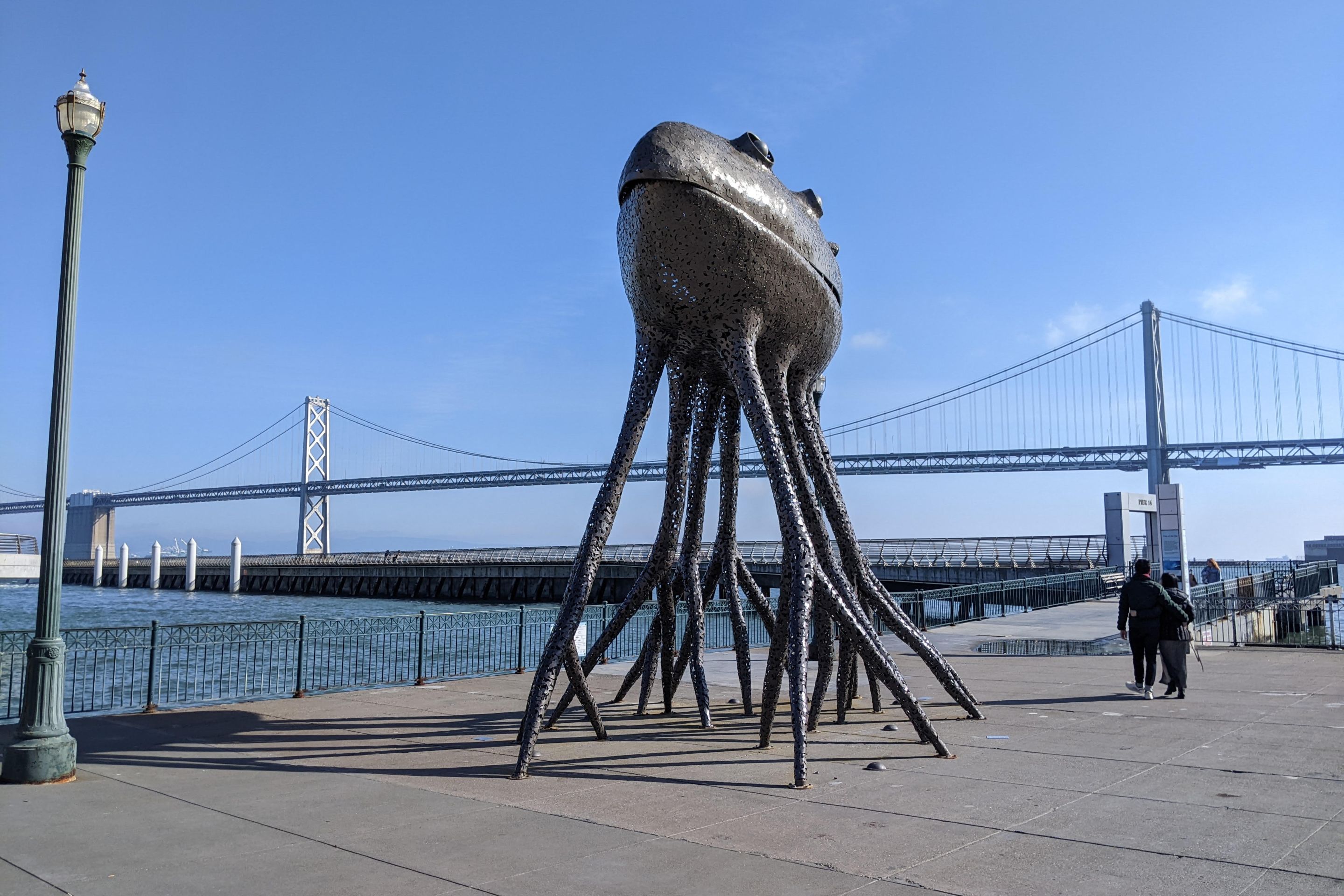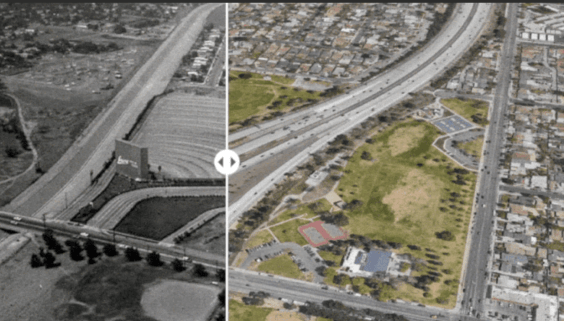Former Talking Heads frontman and current bicycling icon David Byrne used his celebrity and the publication of his new book, Bicycle Diaries, to instruct a capacity audience of more than 900 people at San Francisco's Herbst Theater on the many ways that the bicycle has become a more acceptable and mainstream form of locomotion. Rather than read a single line from his book, he took the opportunity to assemble a panel, including Board of Supervisors President David Chiu, San Francisco Bicycle Coalition (SFBC) Executive Director Leah Shahum, and Berkeley City and Regional Planning Professor Emeritus Michael Teitz, and show a largely older audience of City Arts devotees a number of photos from his travels, photos contrasting cities around the world where bicycle infrastructure is more than a-nod-and-a-wink, to American cities, where the car is king and any other form of transportation has suffered from neglect or marginalization.
 Photo: Gothamist
Photo: GothamistThe event last night was the kickoff for the 29th Annual Literary Events hosted by City Arts and Lectures, a series decidedly literary and focused on the writer's craft, with upcoming readings by Margaret Atwood, Nick Hornby, Joyce Carol Oates, and Michael Chabon. As evidenced by the demographics of the audience and the many negative or hostile retorts about rude and masochistic cyclists blowing stop lights in the question-and-answer period, this was not a typical event organized by the SFBC or city planners, where a talking head or visiting livable streets luminary extols the benefits of the bicycle to a pack of avid cyclists nodding their helmet-marked heads.
One white-haired woman in the audience explained that she wanted to like cyclists, but was on a walk recently with her little dog and they almost got "hit six times" by a crazed cyclist, and there was another time when a bike rider swerved in front of her car and how could they be so crazy? Another man, with a thick salt-and-pepper beard, asked: "How can we get people who ride bikes to stop at red lights and to stop at stop signs?" Teitz, with a droll British cadence responded: "Bicyclist of the Month: somebody who has been noted for stopping at stop signs...the mayor shakes hands, an award is given....."
Still, Byrne and his guest panelists delivered an entertaining ninety minutes for everyone, no matter how familiar they were with urban cycling. Each speaker explained how they came to ride bicycles and what a world would look like where the bicycle was an equal transportation partner with cars and other modes (short answer: Copenhagen). Byrne explained that he has been riding a bicycle in New York City for more than 30 years and he has taken a bicycle on tour with him nearly everywhere. In his slide show, full of humorous anecdotes about his travels and his bicycle, he ran through a number of photos and images of master-planned cities as they have been imagined by the likes of le Corbusier, Frank Lloyd Wright, and General Motors, cities built around cars and naked, empty public spaces, cities devoid of neighborhoods, cities "antagonistic to [their] own citizens."
Byrne lauded the bicycle as utilitarian transport that connects him to neighborhoods: "I ride around on a bicycle as a way of getting around--I don't race or do those things.... I find that I see things and I stop for things that I wouldn't normally stop for if I was in a car." He showed a slide of a barbeque joint in Charlottesville, Virginia, with a sign commanding "Get in Here, Eat Barbeque." Byrne: "We did." Another slide featured houseboat brothels in Utrecht, The Netherlands, beside a street sign depicting mother and child pedestrians. Byrne: "They're charming, they're floating... little floating whore houses. There's a sign that says 'Hold Your Child's Hand.'"
In a short video slide, three young children no older than eight played in a band on a sidewalk for money. Byrne: "This is a band that I saw on the streets of New York--really bad band.... If I wasn't on a bicycle, I wouldn't have stopped to check it out." His final slide was a Frankenstein bicycle made out of the front wheel of a child's scooter, a few pieces of plywood, and no seat. Byrne: "Riding a bike doesn't have to be an expensive thing, you can make them yourself. This one's a little uncomfortable, but it works."
With little fanfare, Byrne wrapped up his presentation and turned the microphone over to Professor Teitz, who explained that growing up in England, bicycles were not considered recreation, but a fundamental transportation mode complimenting transit and walking. "Nobody in their right mind would have considered using them for recreation," he said. "For recreation you walked three miles across country paths and sat in front of pub and then walked back--actually quite nice."
After a brief history of the bicycle in America, where he pointed out the irony that the demand for quality paved roads resulted from the good organizing of the League of American Wheelmen (now LAB), Teitz asked the audience to imagine how San Francisco might have developed if the bicycle were the fundamental mode of transportation, San Francisco without the invention of the automobile. He suggested that the cabal of bicycle transportation planners and engineers might have figured out how to level some of San Francisco's steeper hills, or drilled elevators into them so cyclists could take them up to the highest point of the hill and coast down to their homes or jobs.
Teitz then suggested that the real future of urban transportation ought to be fully multi-modal, with space taken from cars and given back to other modes until they are in a suitable balance. He encouraged thinking beyond mere stripes and lines on the asphalt to innovations like the woonerfs, which compel drivers, pedestrians, and cyclists to pay attention to each other and negotiate space. "The problem of moving away from a single dominant mode is that it can't be done with linear thinking...." As evidence that some of the non-linear, creative thinking might be "finally sinking in," he said he recently found an article on woonerfs in the Interlocking Concrete Pavement Magazine.
SFBC Executive Director Leah Shahum related a harrowing tale not too long after she first started riding a bicycle in San Francisco, when a driver, who was upset that she was taking a lane of traffic on Masonic, forced her to the sidewalk, then drove up on the sidewalk after her for nearly a block. Shahum only escaped when she came upon another car parked illegally on the sidewalk. She darted between the parked car and the house adjacent, but the maniac pursuing her couldn't. "I was shaken, I was angry, and I was now an advocate," said Shahum.
Board of Supervisors President David Chiu boasted of being the only supervisor who didn't own a car, said he didn't get a driver's license until he was 23 and admitted that he had long been a "bike dork." He was grateful, however, "biking is finally cool," largely because of the work of Byrne, the SFBC, and others who promote bicycle culture. Where friends used to rib him for his post-helmet hairdo, or tell him without a car he couldn't attract members of the opposite sex and "Muni dates were not very cool," now he said he feels part of a bigger and more sustained movement that will make cities more livable. His only request of Byrne was to create a music video with bicycles to compete with the "hip hop guy and the fly girls dancing around the cool car." (Clearly David didn't read this post with the world's greatest bicycle videos!)
More seriously, Chiu said San Francisco has not been cutting edge with bicycle policy, despite the city's reputation for progressive thinking. He said the city needs to do a better job of enforcing traffic laws to make cycling safer, that the city should design curbside bike lanes, improved bicycle parking on streets and in buildings, and that the city should reconsider the hidden subsidies we pay to maintain automobility and automobile infrastructure.
We have to think about how to properly value the costs of driving versus cycling.... Our city silently subsidizes the costs of upkeeping our roads, upkeeping our parking. As a city, we need to think about what that means.... Change is not easy. For every change that is proposed, there is a naysayer that will tell you the world will come to an end. With your help, with those of you who care about building our community, who care about building our neighborhoods, who care about protecting our environment, we can transform ourselves, not just one day a year, one day a month, but every single day here in San Francisco.





